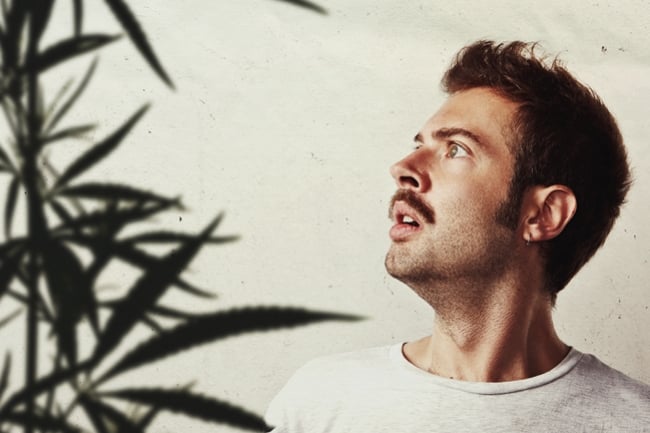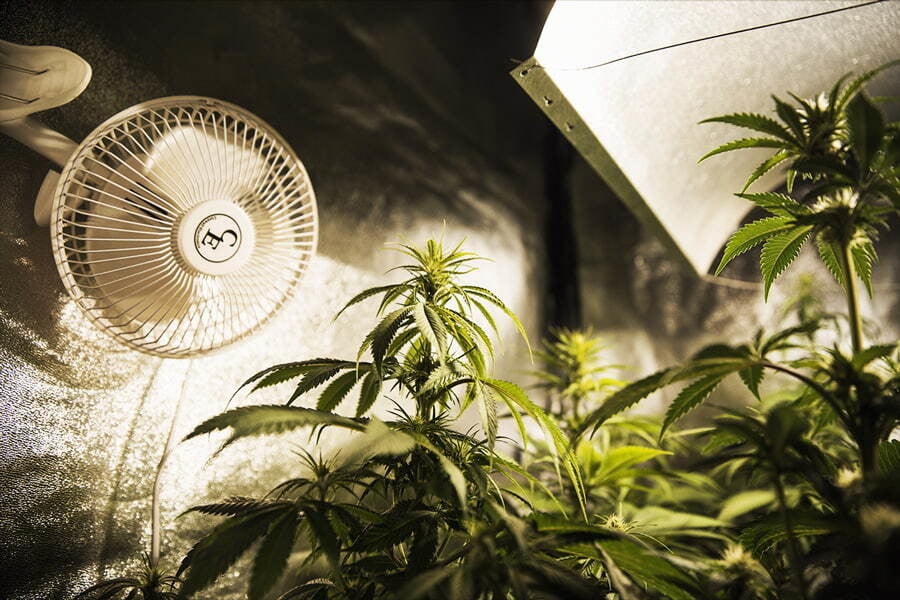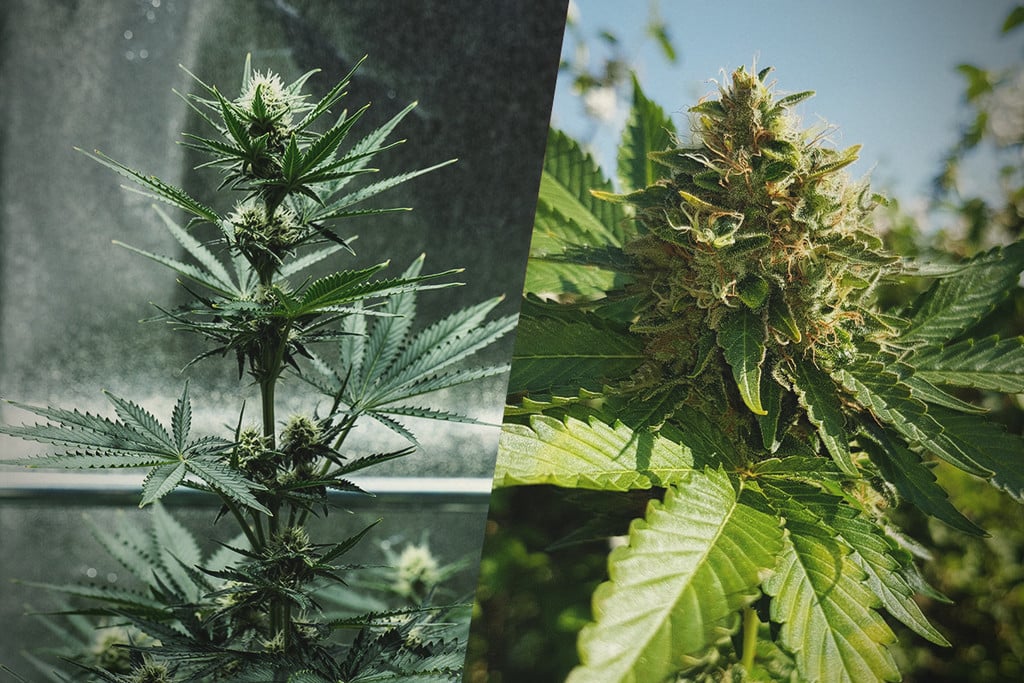.

Growing Weed Indoors vs Outdoors: Pros and Cons
Where's the best place to grow weed? That's a good question! If you asked 10 experienced growers, they'd all come up with slightly different answers. In this article, we'll focus on the main differences between indoor and outdoor growing.
One of the best things about growing cannabis is that you can adapt the hobby to your preferences and situation. If you love nothing more than spending your time outside with the sun on your skin and grass between your toes, you can choose to grow weed in your garden. If you prefer gadgets, control, stealth, and the comfort of the indoors, growing weed inside will win your favour.
But your final growing location doesn’t always boil down to choice. Some growers are forced indoors because of strict laws, while others have to carry out their passion outdoors due to tight budgets or snooping landlords.
If you’re about to grow weed for the first time, or have only ever cultivated in one of these environments, we encourage you to weigh up the pros and cons of each. Before making up your mind, you need to consider all of the different variables. For example, outdoor plants require a minimum of six hours of direct sunlight each day; if you have a north-facing garden or a space overshadowed by trees, you might fail to meet this critical requirement.
But never fear—below, we’ll guide you through the benefits and inconveniences of growing weed outside vs inside.
Benefits (and Inconveniences) of Growing Weed Outdoors
Why should you consider cultivating cannabis outdoors? For one, the plant thrives in this setting—over 12,000 years of domestication is proof of that. But the term “outdoors” is vague. There are many different climates and landscapes in this world, and cannabis doesn’t do well in all of them. Let’s explore the advantages of growing cannabis outdoors, before looking at some of the downsides.
Advantages of Growing Cannabis Outdoors
Exposure to natural sunlight, microbial biodiversity, and increased space all do their part to sway growers to cultivate cannabis outdoors. Not only can you achieve healthy, vibrant plants under the sun, but huge yields too!
-
More Space
Certainly one of the biggest advantages of growing outdoors, adequate space allows cannabis plants to thrive. With ample room to spread their roots and expand their canopies, outdoor specimens can express their full genetic potential.
Transplanting seedlings into garden beds frees them from the constraints of pots and other containers. They’re able to establish large root systems and gain access to large quantities of nutrients and water. Of course, many outdoor growers still elect to use containers. This helps to keep plants at a desirable size. But access to more space means growers can use bigger pots to produce taller and more productive plants.
More space also means more species. That's right, many cannabis growers choose to cultivate companion plants to bolster the biodiversity of their garden, in turn reducing pest damage, decreasing the spread of pathogens, and conserving the soil. This “polyculture” serves as a great biological control method to defend against common pests[1] such as aphids. Moreover, it reduces dependency on chemical controls and shop-bought preparations. Popular companion plant species include white clover, chamomile, dill, and borage.


-
Sunlight
Outdoor cannabis plants spend their days basking in the sunlight. But some experience this luxury much more often than others, depending on the local climate. Much like indoor grow lights, the rays of the sun hit chloroplasts within cannabis leaves and help to drive photosynthesis. But light emitted from the sun offers distinct benefits compared to artificial sources.
The rays of the sun contain two main forms of ultraviolet (UV) radiation: UVA and UVB. The former presents no threat to plants, but the latter can inflict DNA damage. In response to both forms of UV, plants churn out protective layers of resin loaded with secondary metabolites such as cannabinoids and terpenes. Exposure to this kind of radiation may therefore improve the effects, smell, and taste[2] of buds.
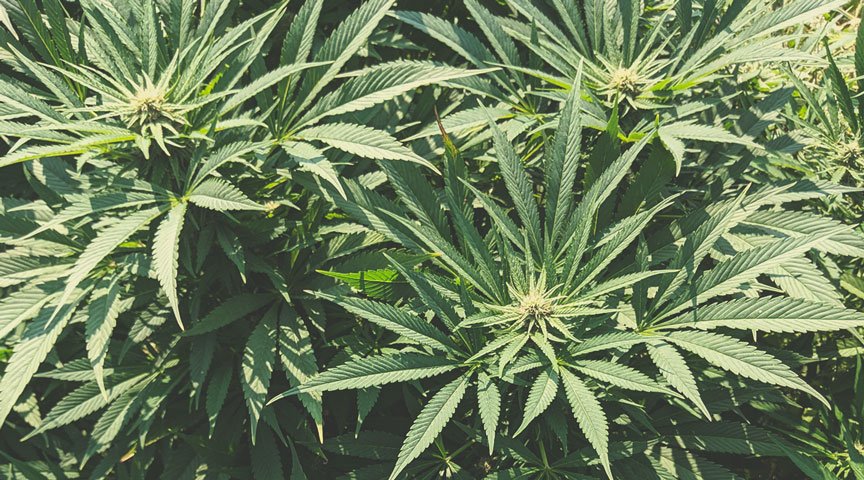
-
Diverse Soil Biology
Outdoor garden beds are teeming with life. By establishing a bed, mulching it generously, and following no-till principles, you’ll create a soil food web thriving with bacteria, fungi, protozoa, nematodes, arthropods, and worms. Together, these species cycle nutrients from organic matter through each other until they become available to plants.
Several forms of bacteria and fungi also form symbiotic relationships with roots and mine vital minerals in return for sugars. Nutrients aside, a healthy soil food web also creates good soil structure. Mycelial threads and bacterial biofilms form soil particle aggregates and prevent erosion, while worms tunnel through the soil, improving aeration and drainage.

-
Cheaper Cost
Growing weed outside can substantially decrease startup costs, especially if you take a minimalist approach. While greenhouses, polytunnels, and irrigation systems aren’t cheap, it only takes a few bags of compost and a couple of sheets of cardboard to create a no-dig bed capable of producing amazing harvests. Even cultivators dealing with short growing seasons can use this technique successfully so long as they have appropriate genetics.
Disadvantages of Growing Cannabis Outdoors
Growing outdoors isn’t all sunshine and rainbows. This dynamic, living environment poses many challenges that can cause anything from minor issues to total crop failures. Check out some of the biggest problems that outdoor growers face.
-
Pest Pressure
If you’ve ever tried to grow vegetables, you’ll know a thing or two about pests. Slugs can wipe out an entire batch of seedlings overnight, aphids can suck a plant dry of sap, and root-munching nematodes can chew holes under the soil without detection. Before growing outdoors, you’ll need to learn how to keep caterpillars, spider mites, whiteflies, and many other species away from your crop.
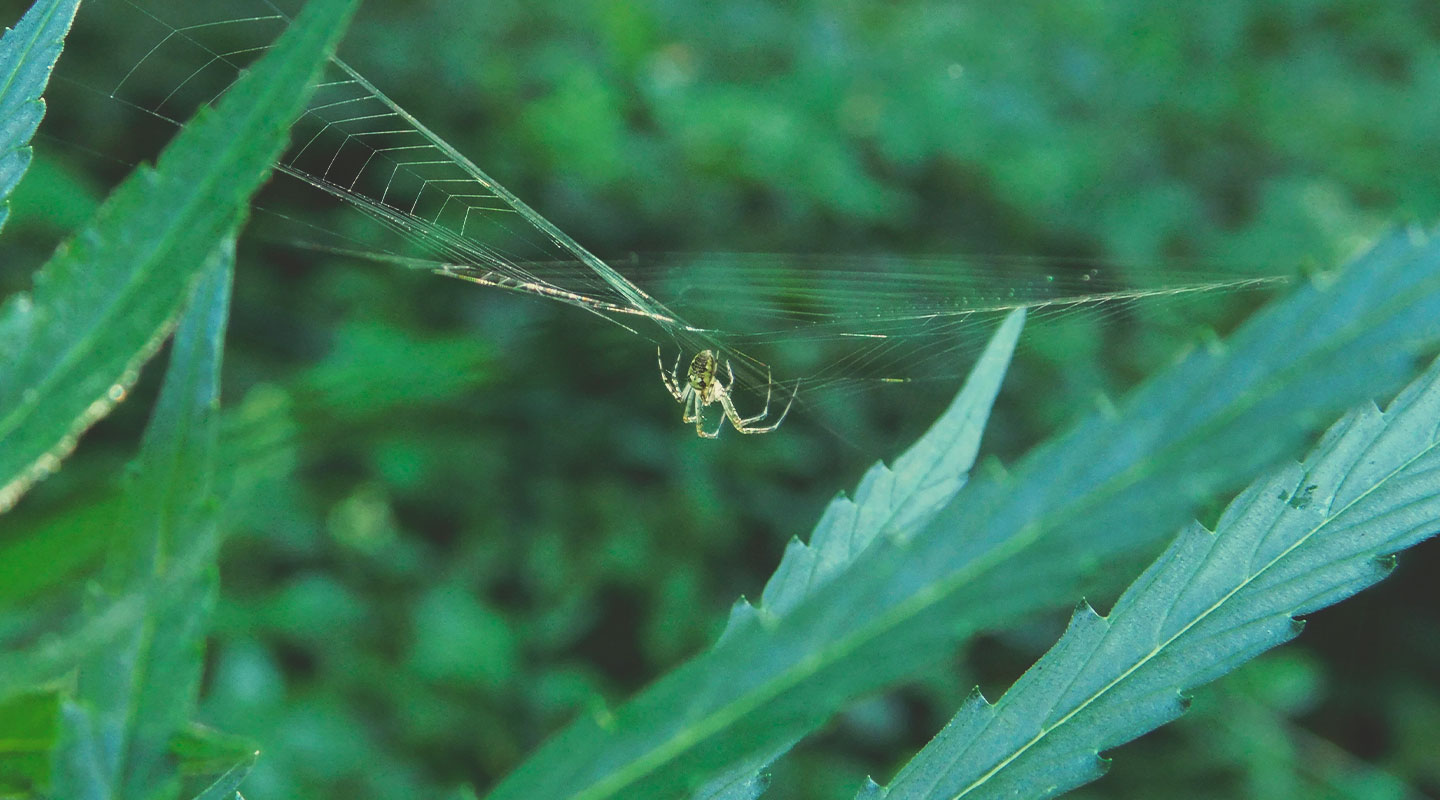
-
Adverse Weather
Many weather events pose a serious threat to outdoor cannabis plants. Gale force winds can snap branches and stems, while torrential rains can cause root rot and increase the chances of disease during the flowering stage. Then there’s the possibility of scorching heat and drought causing underwatering issues and wilting. Late frosts in the spring and early frosts in the autumn can kill plants altogether.

-
Unsuitable Climates
Growing outdoors becomes much harder in northern latitudes. A shorter growing season and rainy weather mean cultivators in these parts of the world are limited to fast-flowering genetics, which usually means smaller specimens and less significant yields. Autoflower strains do particularly well in these environments, but they don’t compare to the productivity of towering, tree-like sativas.


-
Beholden to Mother Nature
Outdoor growers have to move in time with the seasons. While this fosters a close connection with Mother Nature, it means you need to have patience. You can’t alter the light cycle to force photoperiod cultivars to flower early (unless you use light dep techniques). You’ll need to wait for the shorter days to roll in.
-
Less Discreet
Outdoor plants are much more visible than their indoor counterparts. Neighbours and passersby will smell terpenes throughout the flowering stage. Large sativa varieties will poke their canopies above the fence line. Even if you live in a legal area, a canopy loaded with buds is like money to a thief. If you’re looking to evade the law or theft, consider setting up a guerrilla grow away from urban areas.
Benefits (and Inconveniences) of Growing Weed Indoors
Growing indoors provides shelter, control, and stealth. But limited space often prevents plants from reaching their full potential. Although, this doesn’t have to be the case. Discover the pros and cons of growing marijuana indoors below.
Advantages of Growing Cannabis Indoors
Indoor growers dictate almost everything that happens in their grow space. They choose the light cycle and watering schedule, when they want to grow, and never have to worry about strong wind or lashing rain.
-
Greater Control
Control is everything in an indoor grow. The ability to control lighting means plants can receive the optimal amount for robust development: there are no cloudy days in a growing tent. It also means cultivators can choose exactly when to induce flowering in photoperiod strains by nudging the light cycle down to 12 hours on and 12 hours off. Indoor cultivators also have control over important parameters such as temperature and humidity. Maintaining optimal temperature and humidity metrics at different stages of the grow cycle translates to healthier growth and lower risk of disease.

-
Shelter
With four walls, a ceiling, and a floor, you’ll never have to worry about storms destroying plants or excess moisture causing mouldy flowers before harvest. No matter what’s cracking off outdoors, you can visit your plants and enjoy their company comfortably at any time of day.
-
Discretion
Growing indoors means more privacy. Of course, there are a few exceptions, such as living in a shared house or receiving random visits from landlords. However, if you live in a house or apartment that you call your own, you’re good to go! You don’t need to worry about thieves snooping around your garden or the smell of an outdoor crop inundating your neighbourhood. Sure, indoor plants smell just as severe, but the use of carbon filters and odour neutralisers remedies that in no time.
-
Perpetual Harvests

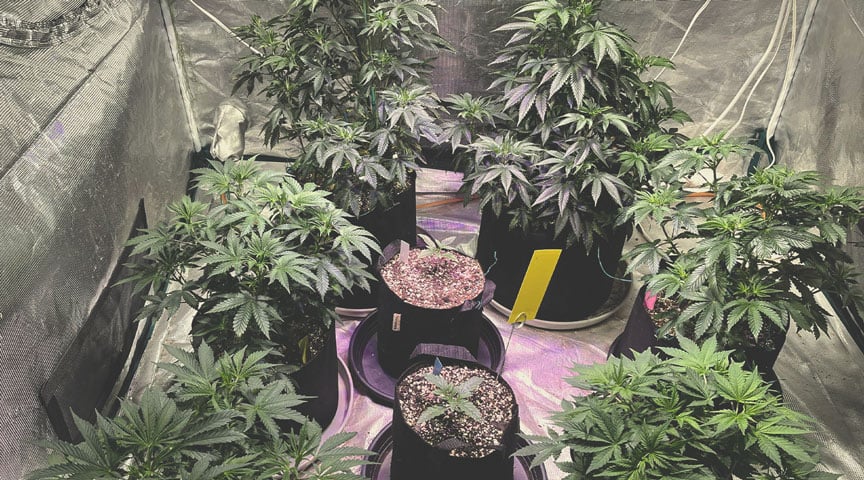
Disadvantages of Growing Cannabis Indoors
All of that warmth, shelter, privacy, and control are tempting, right? But before you start setting up a grow tent in your guest room, you should learn about the downsides of growing between four walls.
-
Less Microbial Life
Indoor environments are relatively sterile compared to outdoor settings when it comes to soil life. If you’re starting a grow with bagged compost, you won’t have the benefits of a highly developed soil food web. You can build up a thriving miniature ecosystem, but it takes time. A greater number of indoor growers are starting to mimic the outdoors in any way they can. Strategies include growing small companion plants, using cover crops, and introducing worms, beneficial bacteria, and mycorrhizal fungi into the soil.
-
More Expensive
Growing indoors comes with some significant startup costs. The pricey pieces of gear you’ll need include high-quality growing lights, a growing tent, fans, carbon filters, and possibly a dehumidifier if you live in a moist climate. On top of that, you’ll need to purchase additional gear (detailed further down). Once you’re set up, you’ll also have to pay slightly more on your electricity and water bills to maintain your operation.
-
Grow Lights Can’t Beat Sunlight
Indoor grow lights do a superb job at raising healthy and productive cannabis plants. However, they lack a key component of sunlight: ultraviolet radiation. As we mentioned above, exposure to UV prompts cannabis to ramp up resin production as a means of protecting itself. Some growers opt to use lights that emit UVA, which in itself helps to increase secondary metabolite production. But the addition of UVB exposure, which further increases terpene and cannabinoid levels, gives outdoor plants a phytochemical edge.
What You Need To Grow Weed
Indoor marijuana growing requires more of an investment, but you still need to get your hands on some gear if you want to grow cannabis outdoors. Both of the checklists below outline some of the key pieces you’ll need to proceed.
Outdoor Gear
| Cannabis seeds of your choice | Growing area (no-dig bed, raised bed, containers) |
| Good-quality compost | Compost bin/area |
| Water butt | Watering cans |
| Organic nutrients | Mulch (hay, straw, compost, dead leaves, grass cuttings) |
| A spot that receives at least six hours of direct sunlight | Insect netting |
| Pruning shears | Trimming scissors |
| Drying rack | Curing jars |
| Cannabis seeds of your choice | Growing area (no-dig bed, raised bed, containers) | Good-quality compost | Compost bin/area |
| Water butt | Watering cans | Organic nutrients | Mulch (hay, straw, compost, dead leaves, grass cuttings) |
| A spot that receives at least six hours of direct sunlight | Insect netting | Pruning shears | Trimming scissors |
| Drying rack | Curing jars |
Indoor Gear
| Cannabis seeds of your choice | Grow tent/room | ||||||
| Containers | High-quality potting soil | ||||||
| Organic nutrients | Lights | ||||||
| Dehumidifier | Fans | ||||||
| Exhaust and carbon filter | Thermo-hygrometer | ||||||
| Trays to catch water | Pruning shears | ||||||
| Trimming scissors | Drying rack | ||||||
| Curing jars | |||||||
|---|---|---|---|---|---|---|---|
| Cannabis seeds of your choice | Grow tent/room | Containers | High-quality potting soil |
| Organic nutrients | Lights | Dehumidifier | Fans |
| Exhaust and carbon filter | Thermo-hygrometer | Trays to catch water | Pruning shears |
| Trimming scissors | Drying rack | Curing jars |
Growing Indoors vs Outdoors—Which Produces Better Cannabis?
In terms of bud quality, both indoor and outdoor growers produce top-tier hauls every year. There are so many variables involved that it’s impossible to rank one above the other in broad brushstrokes. A grower located in Andalusia will probably produce much better weed outdoors, whereas one living in Norway would benefit from the climate control of an indoor growing room. Each environment has obvious benefits, but it all comes down to personal preference and what suits your situation best.
Best of Both Worlds: Indoors AND Outdoors
Why settle for one when you can try both? Some growers are lucky enough to tend to their outdoor crop after spending some time in their indoor growing tent. If you’re new to growing cannabis, why not start in one location, then try the other once you’ve processed your first harvest? Experience is the best teacher, and you’ll only know what works best for you after trying first-hand. Consider making use of the good weather during the spring and summer, before moving your efforts indoors during the darker and colder months.
But there’s also a third option. Greenhouses and polytunnels offer a hybrid approach. They bestow a degree of protection and climate control only possible inside a structure, while also subjecting plants to natural sunlight. However, glass filters out most UVB radiation, and around half of UVA—you can’t win 'em all.
- Insects | Free Full-Text | Companion Plants for Aphid Pest Management https://www.mdpi.com
- UV-B Radiations and Secondary Metabolites | Yavaş | Turkish Journal of Agriculture - Food Science and Technology http://www.agrifoodscience.org



























